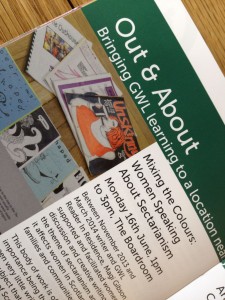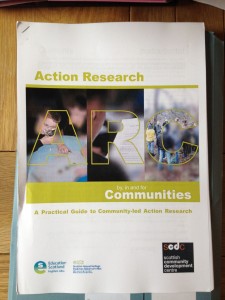 On Wednesday 14th May, hosts Kate McHendry (Development Manager at the Scottish Community Development Centre (SCDC)) and Robin Jamieson (Community Research Officer at Community Links (South Lanarkshire)) welcomed Glasgow Women’s Library’s ‘Mixing the Colours: Women Speaking About Sectarianism’ project back to the Community Action Research in Tackling Sectarianism Co-Inquiry, the second gathering in a series hosted by the SCDC and Community Links (South Lanarkshire) with the aim of bringing together groups who are working on sectarianism awareness projects to share information and ideas.
On Wednesday 14th May, hosts Kate McHendry (Development Manager at the Scottish Community Development Centre (SCDC)) and Robin Jamieson (Community Research Officer at Community Links (South Lanarkshire)) welcomed Glasgow Women’s Library’s ‘Mixing the Colours: Women Speaking About Sectarianism’ project back to the Community Action Research in Tackling Sectarianism Co-Inquiry, the second gathering in a series hosted by the SCDC and Community Links (South Lanarkshire) with the aim of bringing together groups who are working on sectarianism awareness projects to share information and ideas.
This second session followed on from the first Co-Inquiry on 15th January 2014, where we created a ‘baseline’ for future sessions by compiling a broad picture of what sectarianism is, and how it is formed and perpetuated, through discussion of our own experiences, memories and values.
At the end of the first session, we were asked to select one or two specific topics (gender, religion, culture, history, economics, education or community) and to consider specific ways in which these relate to sectarianism. We were asked to bring to the second session our thoughts and research on our chosen topic(s), with the aim of deepening and expanding upon our initial reflections on sectarianism as a broader issue.
What do we really mean when we talk about ‘action research’? Kate and Robin each gave presentations on the topic, highlighting some applications of action research and how it differs from research in the ‘traditional’, academic sense. Generally speaking, action research seeks to move away from the concept of research for its own sake, and towards collaborative, community-based, practical problem solving with positive change as the main indicator of success.
Kate and Robin went on to discuss the concept of ‘co-inquiry’ as an action research process, with first-person, second-person and third-person ‘stages’. With first-person co-inquiry at the heart of action research, we begin by reflecting on our own experiences, values and biases. Second-person co-inquiry then allows us to open our first-person co-inquiry to others (friends, colleagues or other groups), and takes our inquiry into the community. Third-person co-inquiry extends this still further, to larger groups and organisations.
 Towards the end of the session we returned to the broad pictures we had drawn during the first Co-Inquiry, and brought some of our topic-specific findings to bear on what was already represented within them. As more detail emerges from our independent research into each topic, it becomes increasingly clear that sectarianism can’t be properly discussed while it is broadly over-simplified and confined to subjects like football and religion. Just as my own research on gender reinforced the idea that both an individual’s gender and their sexuality inform their experiences of sectarianism, so input from colleagues on economics, history and culture shed new light on sectarianism in the context of issues including economic austerity.
Towards the end of the session we returned to the broad pictures we had drawn during the first Co-Inquiry, and brought some of our topic-specific findings to bear on what was already represented within them. As more detail emerges from our independent research into each topic, it becomes increasingly clear that sectarianism can’t be properly discussed while it is broadly over-simplified and confined to subjects like football and religion. Just as my own research on gender reinforced the idea that both an individual’s gender and their sexuality inform their experiences of sectarianism, so input from colleagues on economics, history and culture shed new light on sectarianism in the context of issues including economic austerity.
This session gave an applied vision of the value of action research in tackling sectarianism, reinforcing the objectives which the Mixing the Colours project has at its heart – using action research and co-inquiry to give voice to the unique lived experiences of women and their communities in order to enhance, develop and perhaps contradict traditional dialogues and perceptions of sectarianism.
The aim of the Mixing the Colours project is to record both the oral and written histories of women (which have, to a considerable extent, been excluded or omitted from the dialogue on sectarianism) through media such as interviews and creative writing. In this respect, the project provides a safe space for women to carry out their own first-person co-inquiries and to encourage them to use their own voices to talk about and tackle sectarianism.
Our thanks go to Kate and Robin for another informative and thoroughly enjoyable session, and to our colleagues in all of the projects for being so willing to share their views and insights with us.
You can find out more about the Mixing the Colours project and how you can get involved here.

One reply on “Mixing the Colours at the Second Community Action Research in Tackling Sectarianism Co-Inquiry”
[…] Blog by Rebecca (Glasgow Women’s Library): https://womenslibrary.org.uk/2014/05/23/mixing-the-colours-at-the-second-community-action-research-in… […]